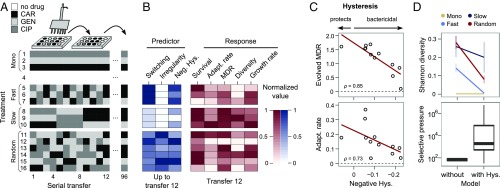Fig. 2.
Negative hysteresis can constrain the bacterial evolutionary response during sequential treatment. (A) Schematic of evolution experiment with three main types of sequential treatments plus controls, including a total of 16 individual protocols. Only the first 12 transfers are illustrated. (B) Variation in tested parameters and measured traits up to transfer 12. The tested parameters include cumulative levels of negative hysteresis (Neg. Hys., dark indicates high levels), switching rate, and regularity of change (dark indicates high irregularity). The evolutionary response was measured for population survival (max = 12), adaptation rate (Adapt. rate, n ≤ 12, extinct lineages excluded), evolved MDR (n = 35), genotypic diversity (n = 20), and exponential growth rate in absence of drugs (weighted mean, n = 3). (C) Negative hysteresis levels (high levels toward right) correlated significantly with evolved MDR (red line shows regression line). (D) A mathematical model predicted lower genotypic diversity and higher selection intensities when accounting for cellular hysteresis.

